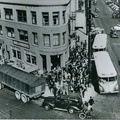Read Part 7 >>
JOURNEY TO THE MAINLAND: MIGRANTS TO SETTLERS
While many Japanese stayed on the Island and made Hawaii their home, many also used Hawaii as a stepping stone to the Mainland, where wages were double. Between 1890 and 1900, Japanese started to arrive in greater numbers in the port cities of San Francisco and Seattle. At the same time, thousands of southern and eastern Europeans landed in New York’s Ellis Island.
It was a period of great world-wide migration to the United States. America, “the land of promise,” beckoned to the adventurous and the ambitious from all parts of the world. The country’s industrial transformation had increased the need for labor. Though the “lure of America” played a great role in the mass migration, the economic and political forces affecting the emigrants in their own homeland largely influenced their decision to leave.1
Charles Bartunek, a Czech from Austro-Hungary explained. “There was absolutely no chance for the common man over there to get ahead. You just lived, and you finally died, and probably the country had to bury you.”2
Bartunek’s countryman, Theodore Lubik, offered a different reason: “They were taking boys all the time for the army, but I didn’t wait until they call me. I skidoo.”3
Roman Umecka remembered, “Poland was poor after the war. You see, everything was smashed. When I came out of the army in1921, I couldn’t find work. Of course, I didn’t think I was going to ever be in America.”4
Leon Solomon from Lithuania recalled, “All Jews had one overwhelming motive to get out of the tyrannical regime of Czarist Russia, where there was no hope for advancement, to come to the freeworld, the land of promise.”5
Initially, most immigrants, both European and Asian, planned to stay only temporarily. Few left with the intentions of never returning to their homelands. All shared the pain of leaving loved-ones behind.
Polish immigrants thought of their families as they sang:
When I journeyed from America,
And the foundry where I labored...
Soon I came to New York City,
Then I left Berlin for Krakow;
There my wife was waiting for me,
And my children did not know me,
For they fled from me, a stranger.
“My dear children, I’m your papa;
Three long years have not seen you.”6
The Chinese sing “Gold Mountain songs,” a favorite one telling of a Gold Mountain man’s journey in 1852:
In the second reign year of Haamfung,
a trip to Gold Mountain was made.
With a pillow on my shoulder,
I began my perilous journey:
Sailing a boat with bamboo poles across the seas,
Leaving behind wife and sisters in search of money,
No longer lingering with the woman
in the bedroom,
No longer paying respect to parents at home.7
Choki Oshiro, who sailed from Okinawa to Hawaii in 1906, cried when his friends later told him how his mother and other women relatives sang and danced with sorrow until his ship slipped our of sight:
My beloved child,
On this auspicious ship;
May your journey be as safe and straight
As if linked by a silk thread.8
Those who left Europe were generally from the middle to lower income levels in their homeland. The very poor seldom left—they couldn’t afford to go—and the wealthy had too much at stake to emigrate. The Japanese immigrants, compared to their European counterparts, arrived in America with more money than most and because of the Japanese system of compulsory education, their educational level was among the highest of all immigrant groups.”9 Like the Europeans, the Japanese were willing to sacrifice a few years of hard work for the sake of their families, but most had no intention of making America their permanent home.
What primarily set the Japanese apart from the European immigrants, however, was the Japanese status as “aliens ineligible to citizenship.” In 1790 Congress had restricted the right to naturalization to aliens who were “free white persons.” In 1870, “aliens of African nativity and persons of the African descent” were made eligible. But the Japanese and the Chinese were denied the right of naturalization on the basis of their race. Their permanent “alien” status rendered them politically impotent.
The Founding Fathers’ intention was to keep America white. In 1751 Benjamin Franklin offered his views on America’s future racial composition, asking, “Why increase the Sons of Africa, by planting them in America, where we have so fair an opportunity, by excluding all Blacks and Tawneys (Asians), of increasing the lovely White!”10
While newly arrived immigrants from southern and eastern Europe found employment in northeastern centers, the Issei worked primarily in the western United States in agriculture, fishing, mining, sawmills, and on the railroads. Congregating in clusters, groups or ghettoes, the new immigrants found comfort, camaraderie, and ethnic pride among their countrymen.
Notes:
1. See John Bodnar, The Transplanted: A History of Immigrants in Urban America (Indiana, 1985), pp. 1-56.
2. David M. Brownstone, Irene M. Franck, and Douglas L. Brownstone, Island of Hope, Island of Tears (New York, 1979), p. 17.
3. Ibid, p. 63.
4. Ibid, p. 82.
5. Ibid. p. 52.
6. In Ronald Takaki, Strangers from a Different Shore, p. 35.
7. Marlon Hom, Songs of Gold Mountain (Berkeley, 1987), p. 39.
8. Choki Oshiro oral history, Uchinanchu, p. 404.
9. Japan’s compulsory education system was enacted in 1872.
10. In Ronald Takaki, Strangers from a Different Shore, p. 16.
* Issei Pioneers: Hawai‘i and the Mainland, 1885 - 1924 is the catalogue accompanying the National Museum’s inaugural exhibition. Using artifacts from the National Museum’s collection to tell the story of the courageous “Issei Pioneers,” the catalogue focuses on the early immigration and settlement years. To order the catalogue >>
© 1992 Japanese American National Museum





